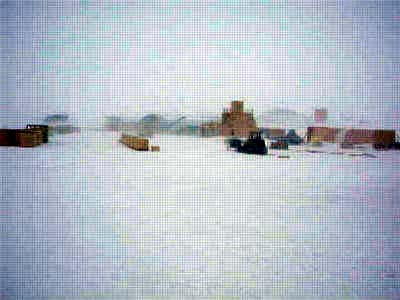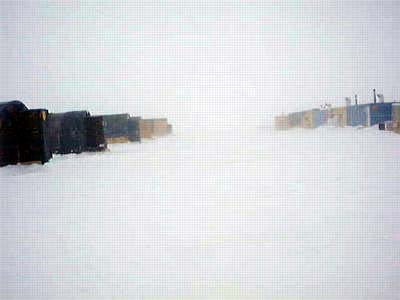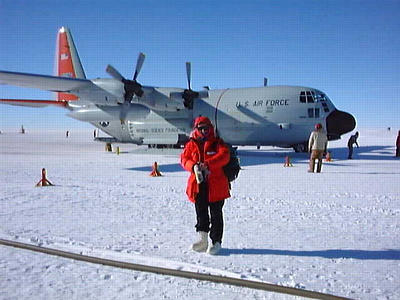14 January, 1999
Thursday, January 14th, 1999, South Pole Station
There was no wake up call for me and I actually slept for 5 whole
hours!! We had our first white out: balloon flights would be
impossible. I walked around in my full gear to take pictures. It was
amazing how fast the snow can drift. It looked like it snows but it
seldom does snow here at the South Pole. The air is much too dry.
Before lunch, I answered my emails, transferred photos, and helped in
the lab. In the afternoon a reporter from the Washington Post visited
our labs at the ARO. Dave talked about the work of his Climate
Monitoring and Diagnostic Laboratory. Andy and Joel introduced some of
the instruments as well and we continued discussing environmental and
political issues.
ARO (Atmospheric Research Laboratory) is located about 1/4 of a mile
upwind from the dome near one of the restricted area, the 'CLEAN AIR
SECTOR'. Because winds persistently blow towards the South Pole from
this direction, the air is virtually untouched by any biota or
pollution. This section contains the cleanest air on Earth. It also
has the cleanest snow on Earth.
Several research groups work Out of the ARO building:
Biospherical Instruments, Inc. has monitoring devices that evaluate
ultraviolet (UV) irradiances using ground-based optical measurements.
Since ozone absorbs UV light, the concentration of ozone in the
stratosphere can be determined. Similar instruments are at other
locations in the Antarctic, in South America, and in the Arctic.
Another group is from the University of Illinois, using laser-based
radar to study Polar Stratospheric Clouds (PSC). PSC are Antarctic
phenomena that, with man-made chemicals that arrive naturally from the
world's populated regions, trigger the famous ANTARCTIC STRATOSPHERIC
OZONE DEPLETION. I will come back to this topic throughout my stay
here at the South Pole.
The people I am working with, and have been trained by in the past
summer in Boulder, are members of the Climate Monitoring and
Diagnostic Laboratory (CMDL) of the National Oceanic and Atmospheric
Administration (NOAA). Dave Hofmann is the director of CMDL, Bryan
Johnson is one of the scientists of the Ozone and Water Vapor research
group at CMDL, Joel Michalski works for the NOAA corps group, and Andy
Clarke works for the CMDL. Both Joel and Andy do all the monitoring
and measurements for NOAA here at the South Pole and transmit all data
back to the CMDL lab in Boulder, Colorado. They have been here since
October and will also stay throughout the Antarctic winter here at the
South Pole. The winter-over season will be completed in October 1999.
NOAA WORK AT THE SOUTH POLE:
NOAA measures pollutants and trace constituents in the atmosphere that
influence global climate. These measurements done from the ground and
balloons monitor climate changes. Other stations like this one here at
the South Pole, Antarctica are on Cape Matatula, American Samoa, at
Mauna Loa, Hawaii, and at Point Barrow, Alaska.
You have learned about one of their monitoring work already:
collecting OZONE PROFILE data using OZONESONDES attached to balloons.
This data collection is done throughout the year here at the South
Pole and at the other CMDL stations.
To determine TOTAL OZONE, measurements on the DOBSON are conducted. In
the 30ties, Mr. Dobson measured ozone by using a prism that disperses
light. He found out that ozone in our atmosphere is important. Mr.
Dobson took his instrument, went around the world to make ozone
measurements, and found out natural differences in ozone levels. The
DOBSON is a spectrophotometer. It contains a prism that splits the
light into different wavelength. Two of this wavelength are selected
and directed to a photo-multiply -tube which sends out the receiving
light as en electrical current. The Dobson compares the two-wave
length. One absorbs the UV light, the other does not. Since Ozone
absorbs UV light, the difference will give the calculation of the
total amount of ozone. I will be doing some of these measurements as
well.
Boulder monitors the Dobson World Standard, meaning that all
instruments in the world have to be calibrated in Boulder.
Other instruments are the NDIR (Non-Dispersal Infrared Analyses) which
measures carbon dioxide based on the principle that this gas absorbs
infrared light. The air is taken from the 'Clean Air Facility' field,
is cooled to minus 85 Celsius (Water absorbs infrared light as well,
so the little there is must be removed by cooling), and send through
the analyzer. The South Pole has the longest standing carbon dioxide
data collection on Earth (since 1957) and is used world wide for
comparison to data collected in populated areas.
Another instrument is the GASCHROMATOGRAPH, which measures
ozone-depleting pollutants such as CFC's and Nitrous Oxide.
NOAA also measures Aerosole parcticles at the Clean Air Facility.
The reporter was very pleased with our discussion. Later on, I
answered more email and after dinner went to the talk Dave Hofmann
gave on 'Greenhouse Gases and Climate Changes - Keeping an Eye on the
Atmosphere at the Ends of the Earth'. I enjoyed the overview of so
many urgent topics I have heard so much about it. Is the world getting
warmer? What does that mean? What can we do?
I just observed the sun again and remembered about yesterday's
question: at what angle does the sun circle around the Pole: about 25
degrees. So, when it is not cloudy, one can always see long shadows
like during late afternoons in the summer in the states. However, it
remains at that angle throughout the day. Of course the angle becomes
smaller a little bit each day and the sun circles around the South
Pole like a decreasing spiral. Question for tomorrow: when will the
sun set?
Got to go and sleep - at least I have to try. Until tomorrow…

White-out at South Pole Station, The picture is taking from my Jamesway. The large wooden structure in the middle of the photo is the Balloon Inflation Facility(BIF). No balloon flights today.

I just stepped out of my Jamesway, the canvas/wooden housing we live in. This is the view of 'Summer Camp' with all the Jamesways in several rows.

Bryan and Joel in front of ARO, the Atmosoheric Reasearch Observatory, also called the 'Clean Air Facility'. It is about 1 kilometer from the station. In the background one can see the resticted 'Clean Air Field'.
Contact the TEA in the field at
.
If you cannot connect through your browser, copy the
TEA's e-mail address in the "To:" line of
your favorite e-mail package.
|
